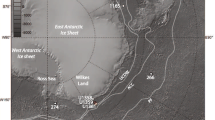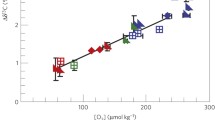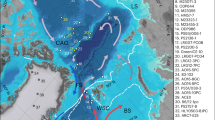Abstract
Six northeast Atlantic cores contain planktonic foraminiferal records implying a very abrupt glacial/interglacial surface-ocean warming roughly coincident with the last deglaciation (isotopic termination II) at 127 000 yr B.P. These faunal composition curves have, however, been substantially altered by sediment mixing processes on the sea floor; they are translated downward in the core record and made to look steeper than they actually were. The reason for this abnormally large mixing impact is an interval of sediment with very low to negligible concentrations of all microfossils (surface ocean and bottom living). These low concentrations reflect a several-thousand-year interval of low productivity and little or no life in the overlying surface waters.
We interpret this thorough suppression of productivity as a consequence of meltwater and icebergs flooding into the subpolar Atlantic gyre from the surrounding Northern Hemisphere ice sheets during deglaciation. The meltwater influx inhibited warm-season productivity by maintaining a well-stratified low-salinity surface layer; in winter, the low salinity layer froze, stopping nutrientrich deep waters from surfacing in normal cold-season convection.
The earth's orbital configuration during this deglaciation created an unusually strong summer insolation maximum and winter insolation minimum in the Northern Hemisphere. Rapid melting and disintegration of the Northern Hemisphere ice sheets induced by strong summer insolation apparently created the meltwater influx; combined with very low winter insolation, the presence of this low-salinity meltwater layer led to unusually extensive sea-ice formation.
The existence of a large region of winter sea ice across the subpolar North Atlantic during deglaciation implies a reduced supply of moisture in winter to the wasting Northern Hemisphere ice sheets. This includes the loss of winter moisture both locally from ice-covered northern waters and regionally from low-latitude winter storms no longer penetrating northward. The winter sea-ice cover thus acts as an amplifier providing positive feedback to the insolation-driven deglaciation process.
Similar content being viewed by others
References
Adam, D. P.: 1975, ‘Ice Ages and the Thermal Equilibrium of the Earth’,Quat. Res. 5, 161–171.
Berger, A.: 1978, ‘Long-Term Variations of Caloric Insolation Resulting from the Earth's Orbital Elements’,Quat. Res. 9, 139–167.
Berger, W. H.: 1978, ‘Oxygen-18 Stratigraphy in Deep-Sea Sediments: Additional Evidence for the Deglacial Meltwater Effect’, Deep-Sea Res.25, 473–480.
Berger, W. H. and Heath, G. R.: 1968, ‘Vertical Mixing in Pelagic Sediment’,J. Mar. Res. 26, 134–143.
Berger, W. H., Johnson, R. F., and Killingley, J. S.: 1977, ‘Unmixing of the Deep-Sea Record and the Deglacial Meltwater Spike’,Nature 269, 661–663.
Bramlette, M. N. and Bradley, W. H.: 1941, ‘Geology and Biology of North Atlantic Deep-Sea Cores between Newfoundland and Ireland: 1. Lithology and Geological Interpretation’,U.S. Geol. Survey Prof. Paper 196-A, 1–34.
Broecker, W. S. Thurber, D. L., Goddard, J., Ku, T.-L., Matthews, R. K., and Mesolella, K. J.: 1968, ‘Milankovitch Hypothesis Supported by Precise Dating of Coral Reefs and Deep-Sea Sediments’,Science 159, 297–300.
CLIMAP Project Members: 1976, ‘The Surface of the Ice-Age Earth’,Science 191, 1131–1144.
Cline, R. M. and Hays, J. D. (eds.): 1976,Investigation of Late Quaternary Paleoceanography and Paleoclimatology, Geol. Soc. of America, Mem. 145, Geol. Soc. of America, Boulder, 464 pp.
Duplessy, J. C.: 1978, ‘Isotope Studies’, In:Climatic Change (Gribbin, J., ed.) Cambridge Univ. Press, New York, 46–67.
Emiliani, C: 1955, ‘Pleistocene Temperatures’,J. Geol. 63, 538–578.
Fairbanks, R. G. and Wiebe, P. H.: 1980, ‘Foraminifera and Chlorophyll Maximum: Vertical Distribution, Seasonal Succession, and Paleoceanographic Significance’,Science, in press.
Flint, R. F.: 1971, ‘Glacial and Quaternary Geology’, John Wiley and Sons, N.Y., 892 pp.
Glass, B. P.: 1969, ‘Reworking of Deep-Sea Sediments as Indicated by the Vertical Dispersion of the Australasian and Ivory Coast Microtektite Horizons’,Earth and Planet. Sci. Lett. 6, 409–415.
Glass, B. P.: 1972, ‘Australasian Microtektites in Deep-Sea Sediments’, In:Antarctic Oceanology, Vol. II,The Australian-New Zealand Sector (Hayes, D. E., ed.) AGU, Washington, D.C.,Antarctic Res. Ser. 19, 335–348.
Goldberg, E. D. and Koide, M.: 1962, ‘Geochronological Sudies of Deep-Sea Sediments by the Thorium-Ionium Method’,Geochim. Cosmochim. Acta 26, 417–450.
Goreau, T.: 1977, ‘Quantitative Effects of Sediment Mixing on Stratigraphy and Biogeochemistry: a Signal Theory Approach’,Nature 265, 525–526.
Guinasso, N. L. Jr. and Schink, D. R.: 1975, ‘Quantitative Estimates of Biological Mixing Rates in Abyssal Sediments’,J. Geophys. Res. 80, 3032–3043.
Hollin, J. T.: 1962, ‘On the Glacial History of Antarctica’,J. Glaciol. 4, 173–195.
Hughes, T., Denton G., and Grosswald, M.: 1977, ‘Was there a Late-Würm Arctic Ice Sheet?’,Nature 266, 596–602.
Hutson, W. H.: 1980, ‘Bioturbation of Deep-Sea Sediments: Oxygen Isotopes and Stratigraphic Uncertainty’,Geology 8, 127–130.
Johnson, R. G. and McClure, B. T.: 1975, ‘A Model for Northern Hemisphere Continental Ice Sheet Variation’,Quat. Res. 6, 325–353.
Kellogg, T. K.: 1976, ‘Late Quaternary Climatic Changes: Evidence from Cores of Norwegian and Greenland Seas’, In:Investigation of Late Quaternary Paleo-oceanography and Paleoclimatology (Cline, R. M. and Hays, J. D., eds.), Geol. Soc. of America Mem. 145, Geol. Soc. of America, Boulder, 77–110.
Lamb, H. H.: 1955, ‘Two-Way Relationships Between the Snow or Ice Limit and 1000–500 mb Thicknesses in the Overlying Atmosphere’,Quart. Jour. Royal Meteorol. Soc. 81, 172–189.
McIntyre, A., Ruddiman, W. F., and Jantzen, R.: 1972, ‘Southward Penetrations of the North Atlantic Polar Front: Faunal and Floral Evidence of Large-Scale Surface Water Mass Movements over the Last 225 000 Years’,Deep-Sea Res. 19, 61–77.
Morley, J. J. and Hays, J. D.: 1979, ‘Cycladophora davisiana: a Stratigraphic Tool for Pleistocene North Atlantic and Interhemispheric Correlation’,Earth and Planet. Sci. Lett. 44, 383–389.
Nozaki, Y., Cochran, J. K., Turekian, K. K., and Keller, G.: 1977, ‘Radiocarbon and210Pb Distribution in Submersible-Taken Deep-Sea Cores from Project FAMOUS’,Earth and Planet. Sci. Lett. 34, 167–173.
Olausson, E.: 1969, ‘On the Würm-Flandrian Boundary in Deep-Sea Cores’,Geologie et Mijnbouw 48, 349–361.
Peng, T.-H., Broecker, W. S., Kipphut, G., and Shackleton, N. J.: 1977, ‘Benthic Mixing in Deep-Sea Cores as Determined by14C Dating and its Implications regarding Climate Stratigraphy and the Fate of Fossil Fuel CO2’, In:The Fate of Fossil Fuel CO 2, (Andersen, N. R. and Malahoff, A., eds.) Plenum, New York, 355–373.
Robinson, E. A.: 1968,Statistical Communication and Detection, Hafner Publishing Co., New York, 113–119.
Ruddiman, W. F. and Glover, L. K.: 1972, ‘Vertical Mixing of Ice-Rafted Volcanic Ash in North Atlantic Sediments’,Geol. Soc. Amer. Bull. 83. 2817–2836.
Ruddiman, W. F. and Glover, L. K. (in press), ‘Mixing of Volcanic Ash Zones in Subpolar North Atlantic Sediments’, In: Bruce C. Heezen Memorial Volume (Scrutton, R. A., Ed.), John Wiley and Sons, London.
Ruddiman, W. F. and McIntyre, A.: 1973, ‘Time-Transgressive Deglacial Retreat of Polar Waters from the North Atlantic’,Quat. Res. 3, 117–130.
Ruddiman, W. F. and McIntyre, A.: 1976, ‘Northeast Atlantic Paleoclimatic Changes over the past 600 000 years’, In:Investigation of Late Quaternary Paleoceanography and Paleoclimatology, (Cline, R. M. and Hays, J. D., eds.), Geol. Soc. of America Mem., 145, Geol. Soc. of America, Boulder, 201–220.
Ruddiman, W. F., Discus, R. L., and Glover, L. K.: 1976, ‘Elimination of Bioturbation Effects in Deep-Sea Sediment Cores by Deconvolution Processing’,Geol. Soc. Amer., Abs. of Annual Meeting, 1079.
Ruddiman, W. F., Sancetta, C. D., and McIntyre, A.: 1977, ‘Glacial/Interglacial Response Rate of Subpolar North Atlantic Waters to Climatic Change: The Record Left in Deep-Sea Sediments’,Phil. Trans. Royal Soc. Lond. B 280, 119–142.
Ruddiman, W. F. and McIntyre, A.: 1979, ‘Warmth of the Subpolar North Atlantic Ocean during Northern Hemisphere Ice-Sheet Growth’,Science 204, 173–175.
Ruddiman, W. F., Jones, G. A., Peng, T.-H., Glover, L. K., Glass, B. P., and Liebertz, P. J.: 1980, ‘Tests for Size and Shape Dependency in Deep-Sea Mixing’,Sed. Geol. 25, 257–276.
Sancetta, C., Imbrie, J., and Kipp, N, G.: 1973, ‘Climatic Record of the Past 130 000 Years in North Atlantic Deep-Sea Core V23–82: Correlation with the Terrestrial Record’,Quat. Res. 3, 110–116.
Shackleton, N. J. and Opdyke, N. D., 1973, ‘Oxygen Isotope and Paleomagnetic Stratigraphy of Equatorial Pacific Core V28–238: Oxygen Isotope Temperatures and Ice Volumes on a 105 Year and 106 Year Scale’,Quat. Res. 3, 39–55.
Thierstein, H. R., Geitzenauer, K. R., Molfino, B., and Shackleton, N. J., 1977, ‘Global Synchroneity of Late Quaternary Coccolith Datum Levels: Validation by Oxygen Isotopes’,Geology 5, 400–404.
Author information
Authors and Affiliations
Rights and permissions
About this article
Cite this article
Ruddiman, W.F., Molfino, B., Esmay, A. et al. Evidence bearing on the mechanism of rapid deglaciation. Climatic Change 3, 65–87 (1980). https://doi.org/10.1007/BF02423169
Received:
Revised:
Issue Date:
DOI: https://doi.org/10.1007/BF02423169




